Being a responsible car owner goes beyond just fueling up and driving. It involves understanding the intricate network of components that keep your vehicle running smoothly and safely. Many crucial car parts under car are often overlooked, yet they are fundamental to your vehicle’s performance, handling, and overall safety. This guide will delve into these essential parts, providing you with a comprehensive understanding of what’s happening beneath your car.
Let’s explore the critical systems and components located under your car, from the engine’s core to the wheels that keep you moving.
Engine Components: The Powerhouse Beneath
Many vital engine components are situated lower in the vehicle, often partially under the car for balance and protection.
Cylinder Block and Pistons: The Heart of Combustion
The cylinder block, a robust structure within the engine, forms the foundational base. Positioned centrally and low down in the engine bay, and therefore somewhat under the car’s structure, it houses the cylinders – hollow chambers where combustion occurs.
Pistons, fitted inside these cylinders with piston rings, move up and down. This motion is critical for converting the explosive force of combustion into mechanical energy, which ultimately drives the wheels. The piston-cylinder assembly is the primary power-generating component in your car’s engine, located deep within the vehicle’s structure.
Crankshaft and Camshaft: Orchestrating Engine Motion
Deep within the engine block, and positioned low in the vehicle, you’ll find the crankshaft and camshaft. The crankshaft converts the linear motion of the pistons into rotational motion, providing the torque that propels your car. This rotational force is then transmitted to the wheels via the powertrain.
The camshaft, working in synchrony, precisely controls the timing of the engine valves, ensuring optimal combustion. Together, these components, located centrally and low down in the engine, coordinate the internal combustion process for smooth and efficient power delivery.
Intake and Exhaust Manifolds: Breathing System
These manifolds manage the airflow to and from the engine. The intake manifold draws air into the engine for combustion, while the exhaust manifold expels the burnt gases. Often located on the sides of the engine block, these manifolds are integral to the engine’s breathing process.
They optimize engine performance, ensuring a balance of power and fuel efficiency. It’s important to remember that electric vehicles do not have intake and exhaust manifolds as they operate without internal combustion.
Powertrain and Gearboxes: Transferring Power Underneath
The powertrain, largely situated under the car, is responsible for transmitting the engine’s power to the wheels.
Different Types of Gearboxes (Transmission): Managing Speed and Torque
Gearboxes, also known as transmissions, are crucial car parts under car, allowing the engine to operate efficiently across different speeds and loads.
Manual Gearboxes: Driver Control
Manual gearboxes give the driver full control over gear selection. By using a clutch, the driver manually engages and disengages gears, adapting to varying driving conditions like road surface, acceleration, and deceleration. These are mechanically complex systems located under the vehicle, requiring driver input for gear changes.
Automatic Gearboxes: Smooth and Effortless
Automatic gearboxes simplify driving by automatically shifting gears. They use a torque converter, a hydraulic coupling, to smoothly manage gear changes without driver intervention. This provides a more relaxed driving experience, with the complex mechanics happening beneath the car.
CVTs: Seamless Acceleration
Continuously Variable Transmissions (CVTs) represent an advanced gearbox design. Using pulleys and belts, CVTs offer an infinite range of gear ratios, resulting in seamless and continuous acceleration. This technology, housed under the vehicle, optimizes fuel efficiency and adapts to changing driving conditions dynamically.
Differential and Driveshaft: Distributing Power to the Wheels
The driveshaft, running along the underside of the car, transmits power from the transmission to the wheels. The differential, typically located in the axle, distributes this power evenly to the wheels, especially when turning.
These components work in concert to ensure efficient power delivery and smooth handling, all happening beneath the car’s body.
Clutch and Torque Converter: Engaging the Transmission
The clutch, in manual transmissions, allows the driver to engage and disengage the engine from the gearbox for gear changes. The torque converter, in automatic transmissions, smoothly transfers engine power to the gearbox.
Both of these components, located within the transmission system under the car, are essential for managing power flow and enabling gear changes.
Fuel and Ignition Systems: Powering Combustion
The fuel and ignition systems, with components located throughout the vehicle but critically under the hood and partially under the car, are essential for engine operation.
Fuel Injection System: Precise Fuel Delivery
Modern engines utilize fuel injection systems for optimal combustion. Fuel injectors precisely spray fuel into the engine cylinders, improving efficiency and power. This system, with injectors located on the engine and fuel lines running under the car, provides superior fuel delivery compared to older carburetor systems.
Spark Plugs and Ignition Coils: Initiating Combustion
The ignition system, comprising spark plugs and ignition coils, ignites the air-fuel mixture in the engine cylinders. Spark plugs create the spark, and ignition coils amplify the voltage needed for this spark. These components, crucial for starting and running the engine, are located on the engine block.
Throttle Body and Air Intake System: Controlling Airflow
The throttle body regulates the amount of air entering the engine, while the air intake system ensures a clean air supply. Working together, they control the engine’s “breathing,” vital for power, fuel efficiency, and overall performance. The air intake system often draws air from the front of the car, while the throttle body is positioned on the engine.
Cooling and Lubrication: Maintaining Optimal Temperature
Cooling and lubrication systems are vital for preventing engine overheating and ensuring smooth operation. Many components are located around the engine and radiator, at the front and under the hood.
Radiator and Cooling Fans: Heat Dissipation
The radiator dissipates heat from the engine coolant, while cooling fans enhance airflow to expel excess heat. These components, typically located at the front of the car behind the grille, maintain engine temperature and prevent overheating.
Water Pump and Hoses: Coolant Circulation
The water pump circulates coolant throughout the engine, absorbing heat. Hoses carry the coolant between the engine, radiator, and other cooling system components. These parts ensure continuous coolant flow, regulating engine temperature.
EV Battery Cooler System: Thermal Management for Electric Vehicles
Electric vehicles employ specialized cooling systems to manage the temperature of the battery and electric motor. Battery coolers, similar to radiators, dissipate heat from the battery coolant. Maintaining optimal temperature is crucial for battery longevity and efficiency in EVs.
Oil Pump and Oil Filter: Engine Lubrication and Cleaning
The oil pump circulates engine oil, lubricating engine components to minimize friction and wear. The oil filter removes impurities from the oil, keeping it clean and effective. These components, typically located on the engine block, extend engine life and ensure smooth operation.
Electrical System: Powering the Vehicle
The electrical system, running throughout the car including underneath, powers various vehicle functions, from starting the engine to operating accessories.
Battery: Initial Power Source
The car battery provides the initial power to start the engine and supports electrical functions. Located usually under the hood or sometimes in the trunk, it’s the primary electrical energy storage.
Alternator: Recharging and Power Supply
The alternator recharges the battery and powers the car’s electrical system while the engine is running. Converting mechanical energy to electrical energy, it ensures a consistent power supply and prevents battery drain.
Starter Motor and Solenoid: Initiating Engine Start
The starter motor turns the engine to initiate combustion, and the solenoid activates the starter motor. This system converts electrical energy into mechanical motion to start the engine.
Wiring Harness and Fuses: Electrical Distribution and Protection
The wiring harness distributes electricity throughout the vehicle, connecting all electrical components. Fuses protect the electrical system from overloads, preventing damage and ensuring safety.
Suspension and Steering: Ride Comfort and Control
The suspension and steering systems, located directly under the car, are crucial for ride comfort, handling, and vehicle control.
Shock Absorbers and Struts: Dampening Vibrations
Shock absorbers and struts absorb shocks and vibrations from the road, providing a smoother ride. Struts also provide structural support. Located at each wheel, they ensure ride comfort and vehicle stability.
Control Arms and Bushings: Stability and Handling
Control arms connect the suspension to the vehicle frame, and bushings provide flexibility within these connections. They absorb road imperfections, maintain wheel alignment, and ensure balanced handling.
Power Steering Pump and Rack: Effortless Steering
The power steering pump generates hydraulic pressure, and the steering rack converts this pressure into steering motion. Together, they provide effortless and precise steering, enhancing maneuverability.
Braking System: Ensuring Safety
The braking system, with components at each wheel and running along the undercarriage, is paramount for vehicle safety.
Brake Pads: Friction for Deceleration
Brake pads create friction against brake rotors to slow down the vehicle. Made of composite materials, they are designed for durability and reliable braking performance.
Brake Calipers: Applying Braking Force
Brake calipers house pistons that press brake pads against the rotors when you apply the brakes. This creates the friction needed for controlled deceleration.
Exhaust System: Emission Control and Noise Reduction
The exhaust system, running underneath the car from the engine to the rear, manages exhaust gases and reduces noise.
Catalytic Converter: Reducing Harmful Emissions
The catalytic converter reduces harmful gases like carbon monoxide by converting them into less harmful substances. This is a critical component for emissions control.
Muffler and Resonator: Noise Control
The muffler reduces exhaust noise, and the resonator fine-tunes sound frequencies. Together, they ensure acceptable noise levels and a pleasant driving experience.
Oxygen Sensors: Monitoring Exhaust Gases
Oxygen sensors monitor oxygen levels in the exhaust gases, providing data to the engine control unit. This information optimizes fuel injection and reduces emissions.
Interior Components: Driver and Passenger Comfort
While primarily inside the cabin, some interior components have connections and wiring that run under the car.
Seats & Seat Belts: Safety and Comfort
Seats provide comfort and support, while seat belts are crucial safety devices. Both are anchored to the car’s chassis, which is under the car’s body.
Dashboard & Steering Functions: Driver Interface
The dashboard displays essential information, and steering wheel controls provide access to various vehicle functions. Wiring for these systems runs throughout the car, including underneath.
Exterior Components: Vehicle Aesthetics and Protection
Exterior components contribute to the car’s appearance and protect underlying systems, some of which are connected to parts under the car.
Features & Controls on Doors: Convenience and Security
Door features like power windows, locks, and mirrors enhance convenience and security. Wiring for these systems runs through the doors and into the car’s main electrical system.
Wheels and Tyres: Contact with the Road
Wheels and tyres are the car’s direct contact points with the road, and their condition is critical for safety and performance.
Types of Tyres and Their Functions
| Type of tyre | Function |
|---|---|
| Summer tyres | Optimal grip and handling in warm, dry, and wet conditions. |
| Winter tyres | Enhanced traction on snow and ice in cold climates. |
| All-season tyres | Balanced performance in various conditions, wet and dry weather. |
| Performance tyres | Superior handling, grip, and responsiveness for sporty driving. |
| Off-Road tyres | Rugged treads and sidewalls for enhanced traction on challenging terrains. |
| Run-flat tyres | Allow driving after a puncture at reduced speeds for a limited distance. |
| Touring tyres | Smooth, comfortable ride with low noise for long journeys. |
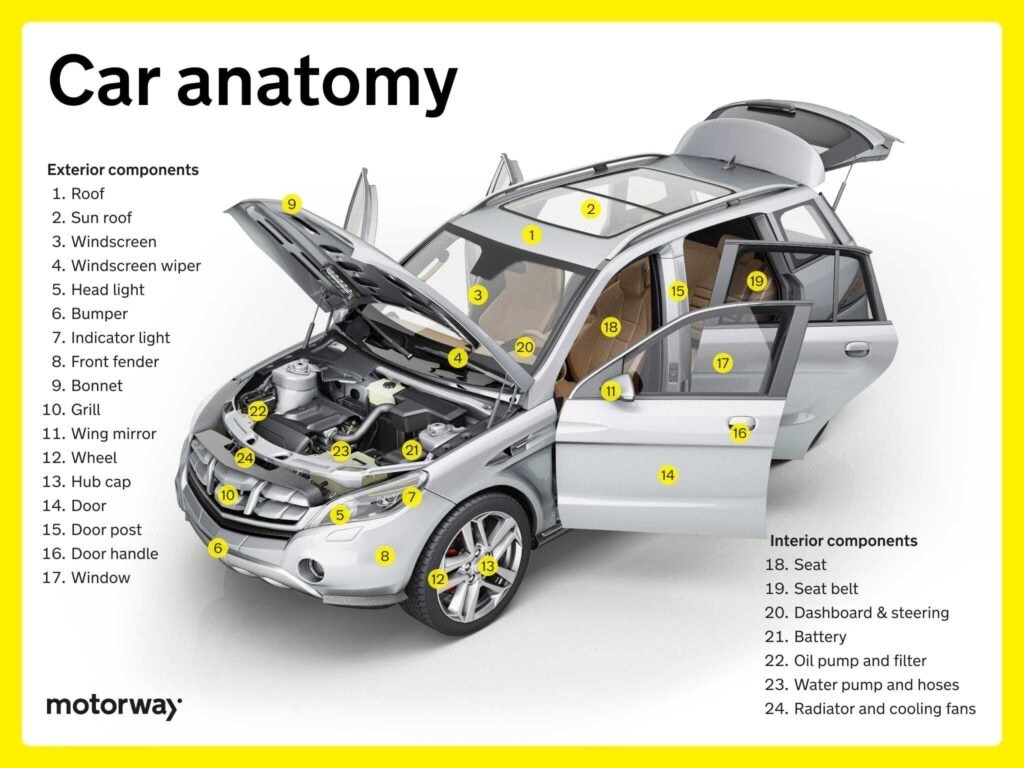
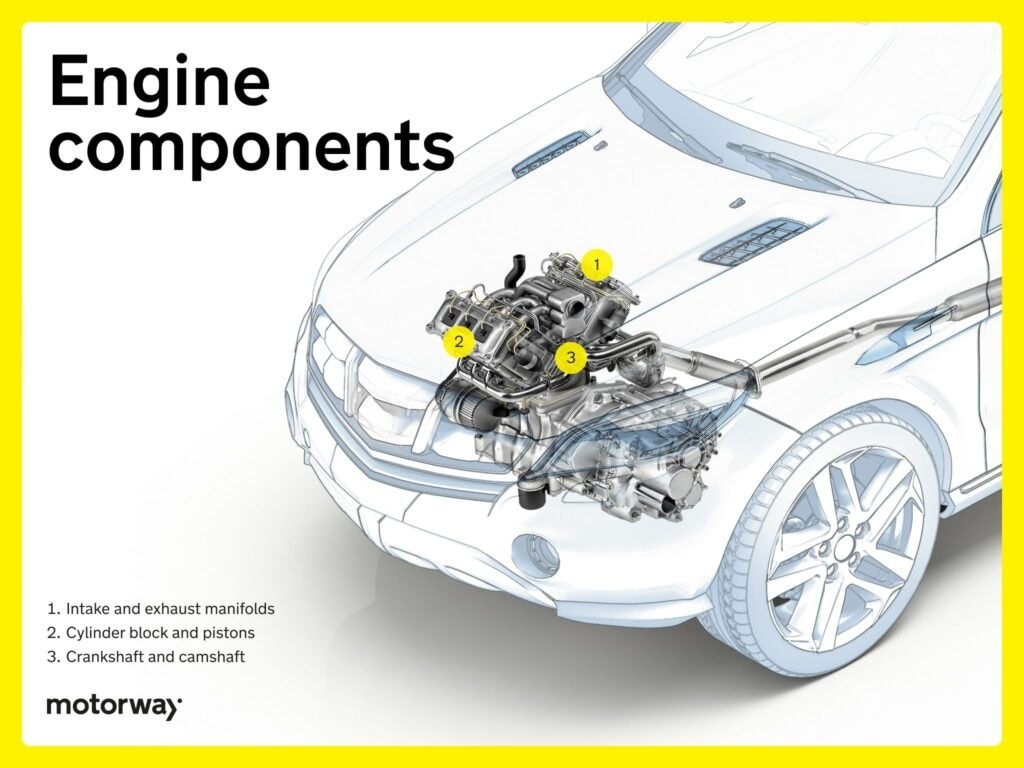
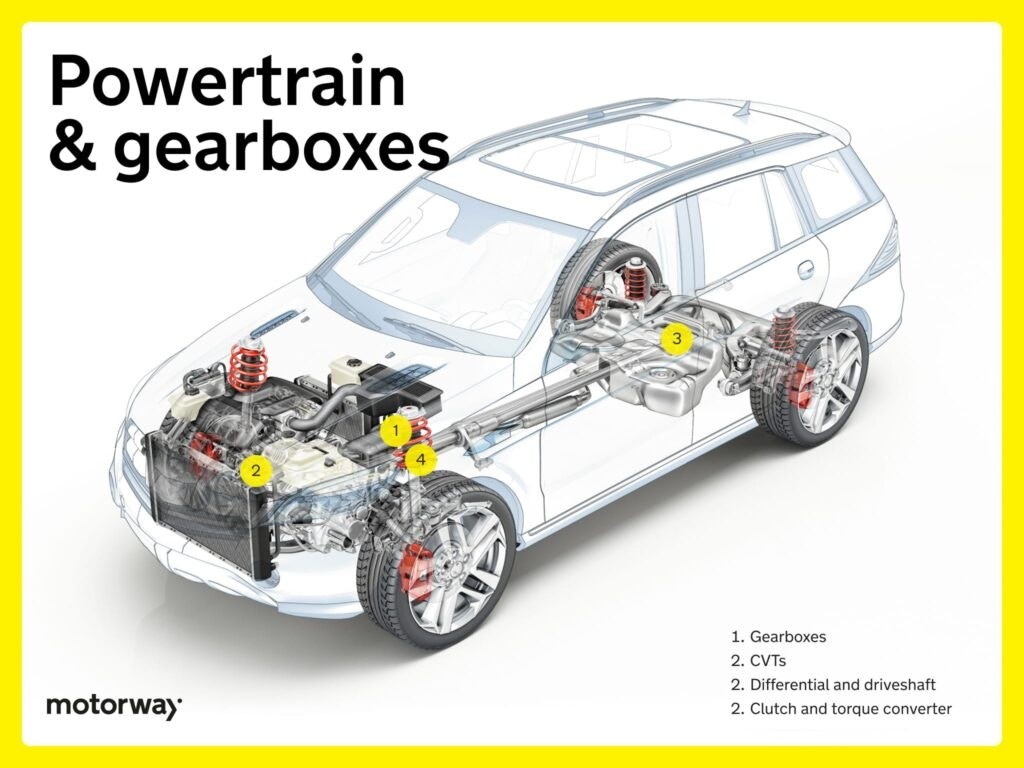
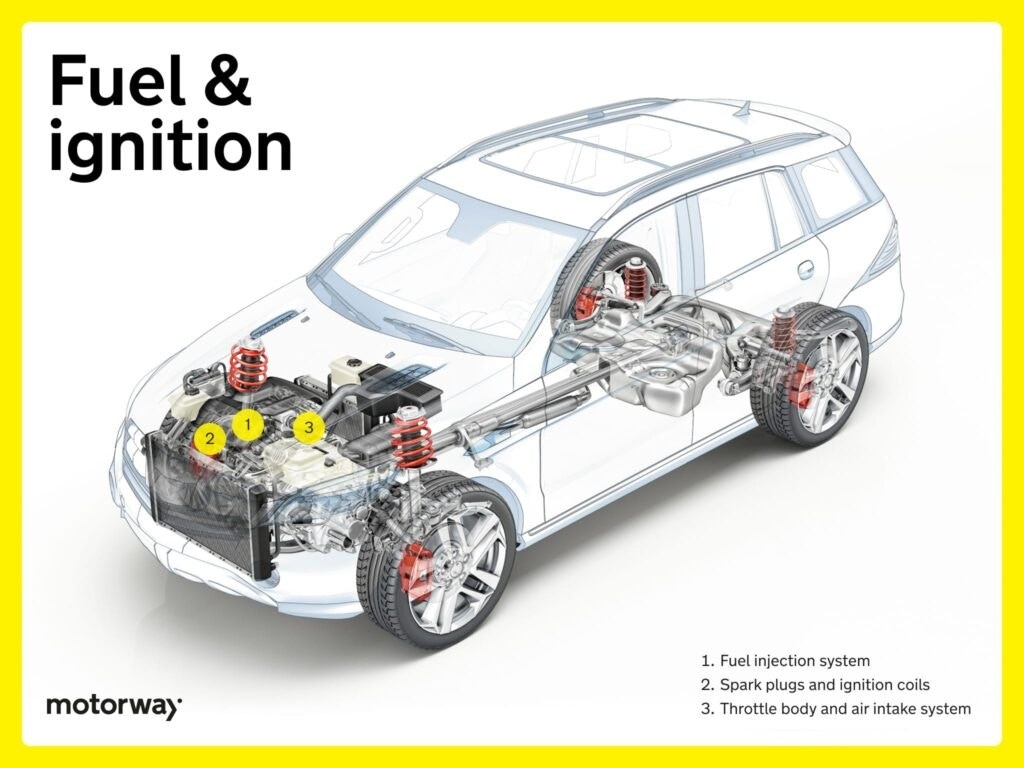
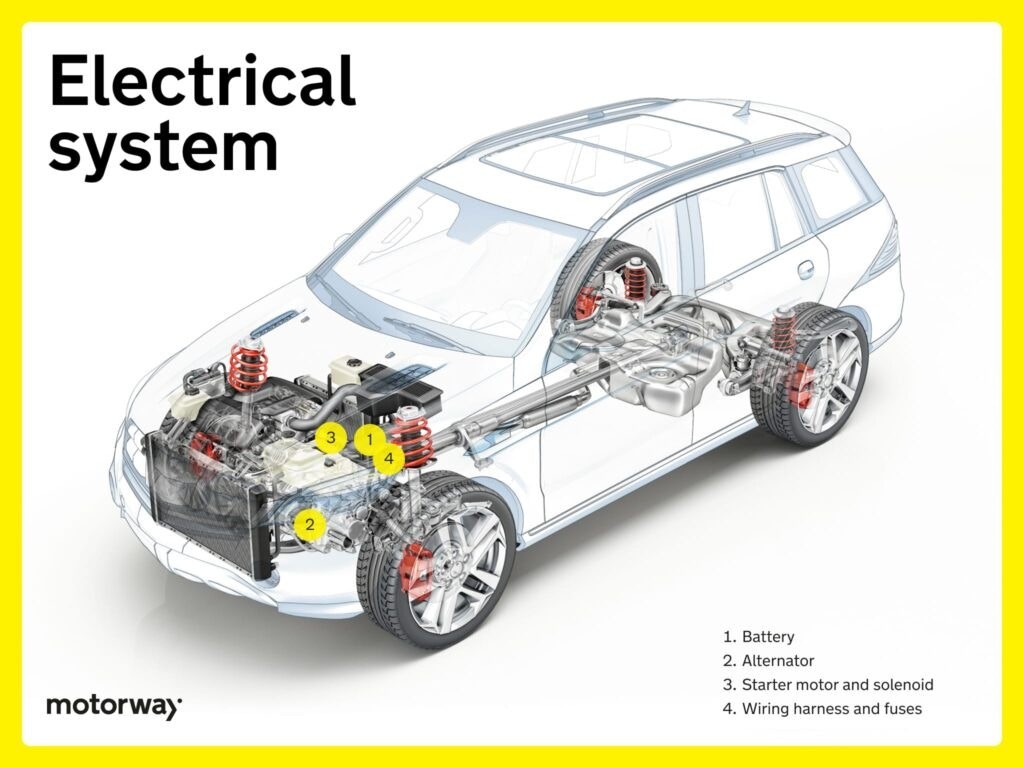
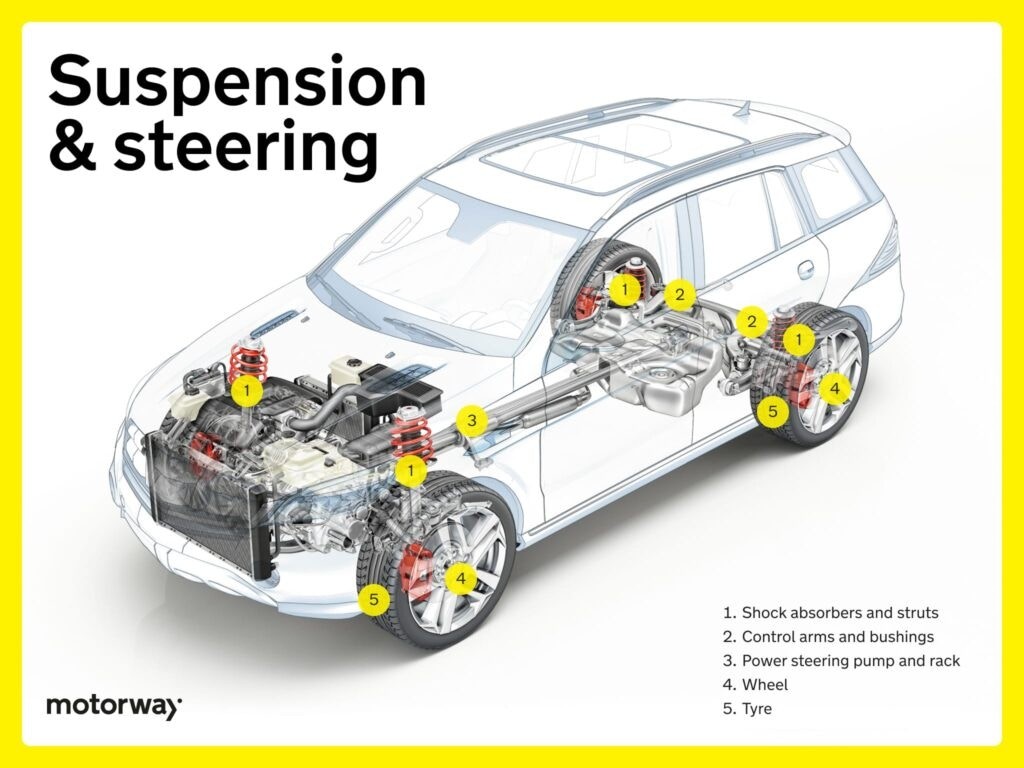
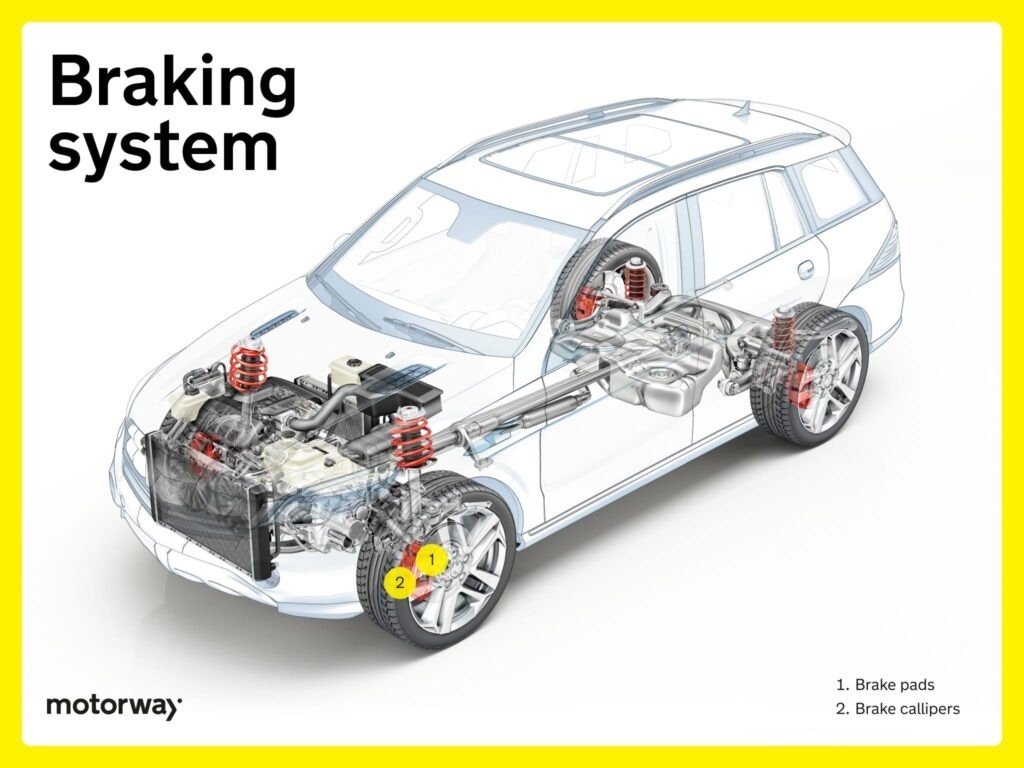
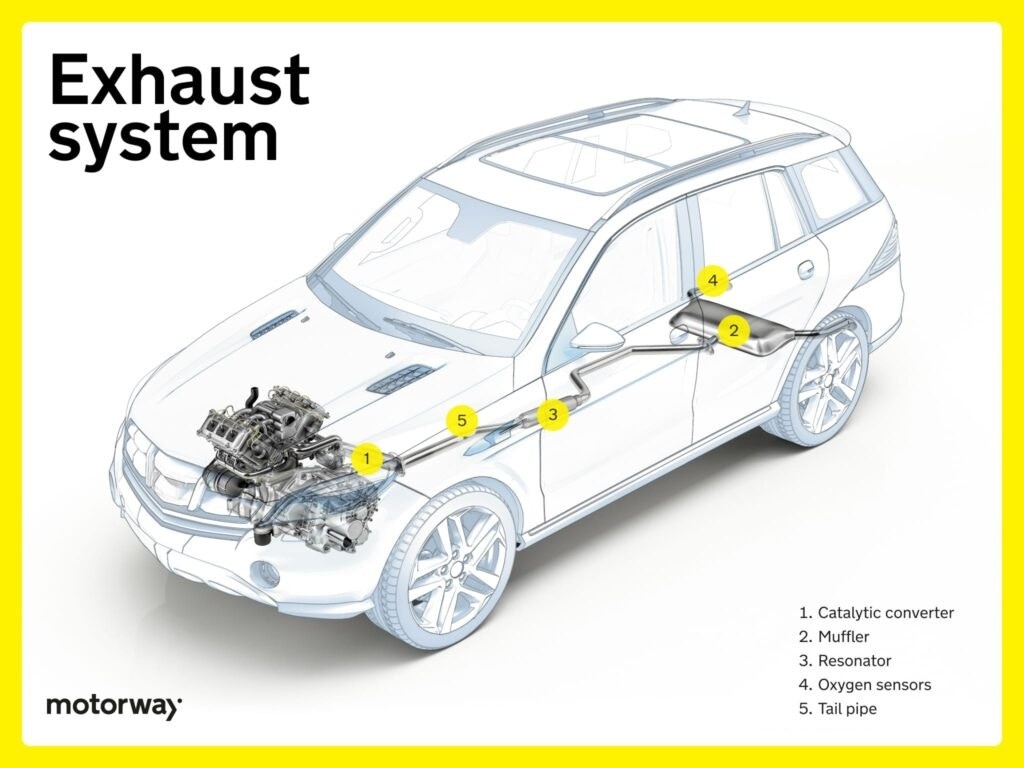
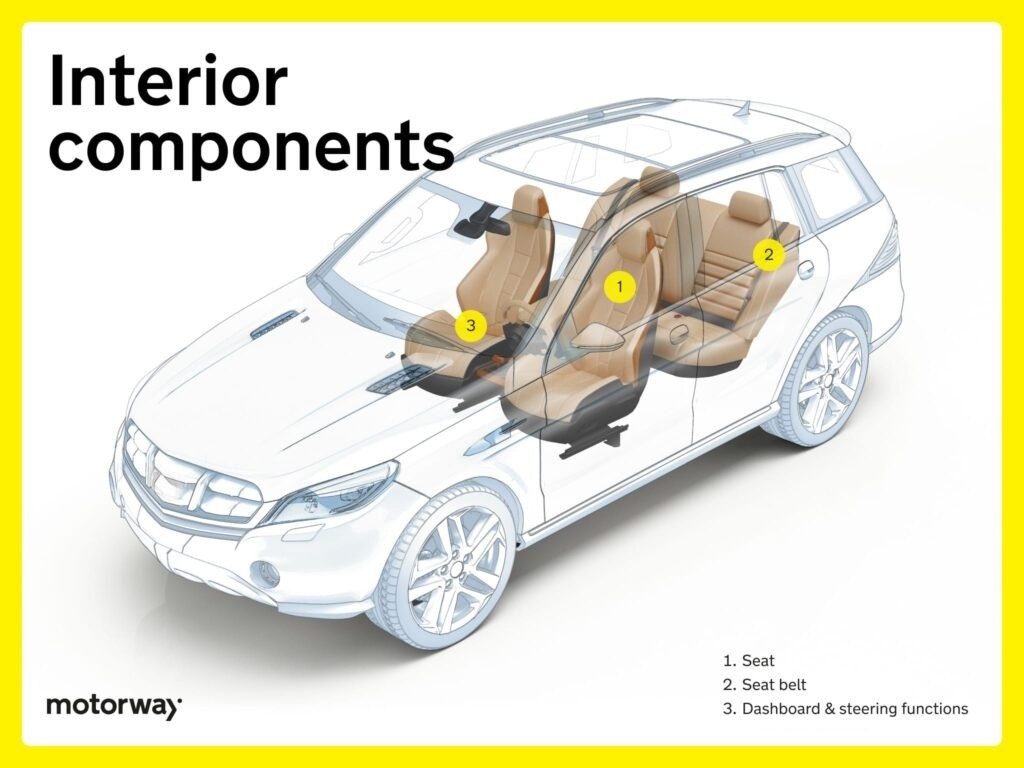
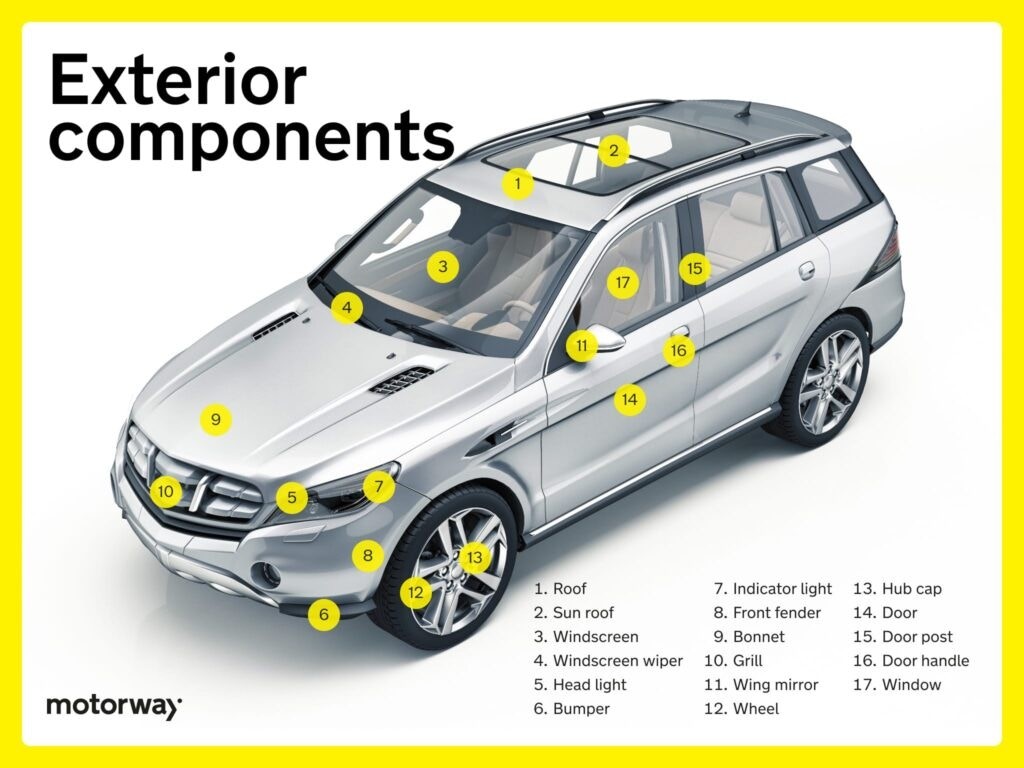
Wheel Construction Guide: Alloy vs. Steel Wheels
- One-piece construction: Single material, common for alloy and steel wheels.
- Two-piece construction: Center and rim bolted or welded, often in performance wheels.
- Three-piece construction: Customizable modular design, popular in aftermarket wheels.
- Forged construction: Stronger and lighter due to high-pressure compression, used in high-performance applications.
- Multi-piece construction: Versatile customization with center, rim, and bolts.
Material choices include:
- Alloy wheels: Lightweight mix of metals, better heat dissipation and aesthetics.
- Steel wheels: Robust and durable steel, cost-effective and suitable for rugged conditions.
Tyre Pressure Monitoring System (TPMS)
TPMS monitors tyre pressure using sensors, warning drivers of deviations from optimal levels. This enhances safety, fuel efficiency, and tyre lifespan.
FAQs About Car Parts Under Car
What parts are under a car?
Crucial car parts under car include the engine, transmission, suspension, exhaust system, and fuel system. These systems work together beneath the car to ensure functionality and performance.
How many car parts are on a car?
Modern cars can have over 30,000 parts, highlighting the complexity of automotive engineering. EVs typically have fewer parts due to simpler powertrains.
What are the important parts of a vehicle?
Key vehicle parts are the engine, transmission, brake system, steering system, suspension, and electrical components, all vital for safety and reliable operation.
What parts of a car can be sold separately?
Engines, transmissions, body parts, and specific electrical parts can be sold separately, offering options for repairs, replacements, and upgrades.
Why is there a shortage of car parts?
Car part shortages arise from supply chain disruptions, increased demand, manufacturing challenges, and global events affecting production and distribution.
Need to Sell Your Car?
Want to learn more about car ownership, maintenance, and selling your car? Explore our guides here for information on various topics from Clean Air Zones to car tax.